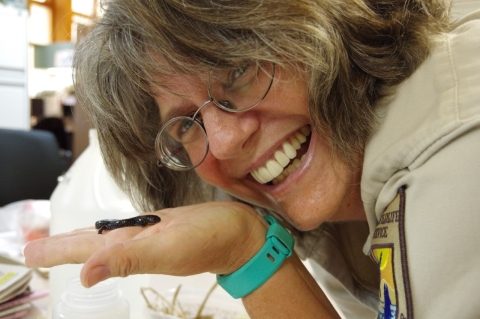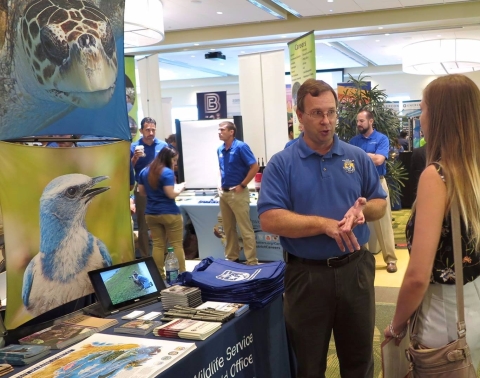Biologists Billy Brooks, Terry Peacock, and Miles Meyer have a combined almost 100 years of service with the U.S. Fish and Wildlife Service. And they eagerly share their extensive reservoirs of knowledge and expertise with up-and-coming Service employees and potential employees.
Find Careers With the U.S. Fish and Wildlife Service
The three veteran biologists say these key elements have contributed to their long and successful Service careers:
- Get a mentor and be a mentor.
- Find something you’re passionate about, that engages your values, and dive in.
- Be flexible, open-minded, and see the “big picture” about assignments and policies.
- Build a support network of experts and trusted agents you can lean on and learn from.
- Get into challenging positions that keep you growing and learning new skill sets.
- Take advantage of continuous learning/professional development opportunities.
Brooks grew up idolizing legendary oceanographer Jacques Cousteau, dreaming about sailing on the Calypso and becoming an oceanographer. Neither of those dreams came true, but Brooks, of the Florida Ecological Services Office, says his life as a Service biologist for 25 years has been very fulfilling.
“It hasn’t been as exciting as sailing around the world on the Calypso, but over these years I’ve still developed a worldly perspective on wildlife conservation,” Brooks says. “That has been the benefit of working on the recovery of several species and developing partnerships. … Just look at the suite of species I’ve worked with, from manatees to beach mice and piping plovers to wood storks and more. It’s been an amazing experience.”
Recognizing that his career is winding down, Brooks says, “I’m looking for opportunities to mentor others and to basically replace myself. Lots of good people are coming into the Service — helping us work smarter and more efficiently. The Service will be in good hands, especially in regard to technology and mining for data and information.”
In addition to finding good mentors, Brooks says employees young in their careers can grow by presenting at workshops and seminars, and continuously looking for bigger and more ambitious projects to engage with.
“When I’ve seen somebody doing impressive things I’m interested in, I’ve tried to develop working relationships with them and looked for opportunities to help them,” Brooks says.
Peacock, manager of St. Marks and St. Vincent National Wildlife Refuges in the Florida Panhandle, has been with the Service for about 39 years. Like Brooks, she’s dedicated to mentoring and passing along her passion for conservation to those climbing up the ladder behind her.
“I tell students interested in coming to work for the Service or wherever they’d like to establish a career: ‘Find a job that you enjoy and you’ll never really have to work for the rest of your life.’”
When Peacock speaks at college career fairs, she tells students interested in working for the Service to find volunteer opportunities that can be counted as experience. She also tells them to get the list of education requirements for the job series they’re interested in and make sure they take those courses. “Unfortunately, a lot of people graduate from college short of the courses they really need to be able to do the jobs we have available,” she adds.
Meyer supervises an Everglades Restoration Team for the Florida Ecological Services Office. Two of his additional duties are running the office’s diversity outreach and volunteer programs. He coordinates visits to college campuses to educate students about career opportunities with the Service and also recruits volunteers to help staff get their jobs done.
“I started as a college student volunteer with the Service about 30 years ago in Jacksonville,” Meyer says. “That opportunity opened doors and led me to where I am today. I built a good network and gained great experience as a volunteer. I want to give them the same opportunity I had to realize there are ways to get involved and start building their careers while they’re still in school and/or are looking to get their foot in the door as a volunteer.”
We know that our conservation mission needs a diverse workforce to succeed. Adds Meyer: "We started our Diversity Outreach Team because we wanted to be in lockstep with the Service's commitment to workforce diversity and inclusion as it relates to attracting and developing a talent pool of employees and volunteers who better reflect the diversity of the American people. It’s especially important to engage with underrepresented groups.”
Career opportunities in the Service aren’t limited to life sciences. Jobs are available in fields such as public land management, law enforcement, information technology, maintenance, real estate, engineering, communications, cartography, finance, budgeting, public policy, and more. Even aviation.
For example, although Peacock is a refuge manager and a biologist, she’s heavily involved in land acquisition at St. Marks. “By the time I leave here, it will probably be close to 12,000 to 14,000 acres of land I’ve helped protect,” she says. “That’s a lasting legacy I’m proud of.”
A common thread between Meyer, Brooks and Peacock is their passion for conservation. Peacock says, “I always tell myself this: ‘Remember why we do what we do! I’m here protecting wild places for wildlife for future generations.’ Feeling that passion and instilling it in others has been a driving force in my career.”







